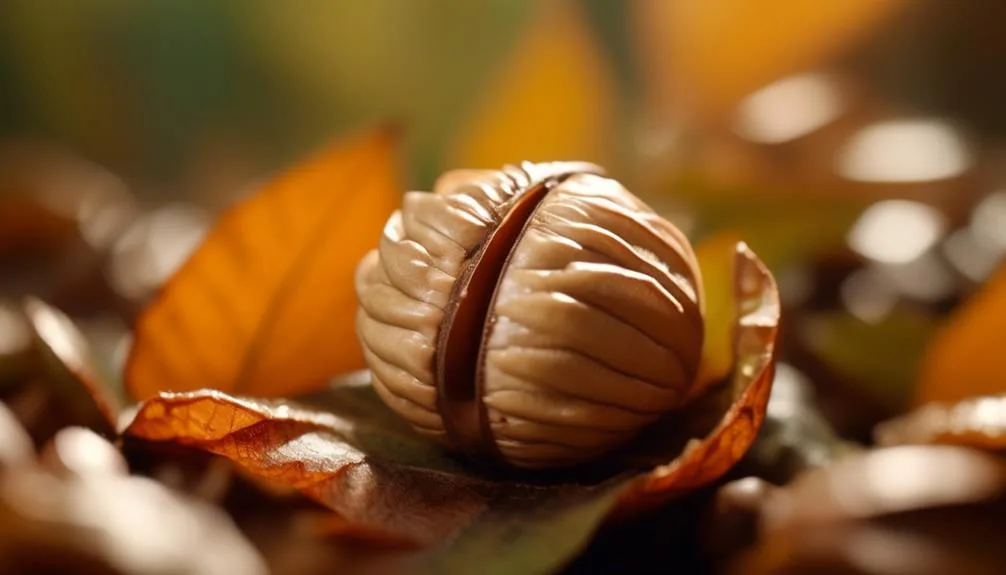Have you ever wondered about the edible potential of beech nuts? These tiny triangular nuts have a long history as a food source, going back to ancient times. If you've encountered them during your walks in the woods, you might be curious about their edibility and nutritional value.
Before considering adding them to your diet, it's essential to understand their identification and any necessary precautions. Let's delve into the world of beech nuts and explore their potential as a culinary ingredient.
Identification of Beech Nuts
To identify beech nuts, you should look for small, triangular nuts encased in spiky, burr-like husks that typically grow in clusters on beech trees. These nuts have distinctive identifying features such as a smooth, light brown shell with a darker brown triangular mark.
The nuts are usually in season during late summer and early fall, making them available for foraging during this time. When searching for them, keep an eye out for beech trees in deciduous forests, as these are the trees where you're most likely to find them.
Beech nuts are a valuable food source for wildlife and can also be foraged by humans for their edible seeds, provided they're properly identified and prepared. Always ensure that you have positively identified the nuts before consumption.
Edibility of Beech Nuts
If you've come across the distinctive beech nuts described earlier, you may be wondering whether they're edible.
Beech nuts are indeed edible and are often foraged for their nutty flavor. They're typically in season from late summer to early fall, so keep an eye out during this time for their seasonal availability.
When foraging for beech nuts, look for trees with smooth, gray bark and oval, toothed leaves. The nuts are encased in a spiky husk, which splits open when they're ripe.
Once collected, beech nuts can be roasted to enhance their flavor or eaten raw. However, it's important to note that some people may be allergic to beech nuts, so it's advisable to consume them in moderation, especially if it's your first time trying them.
Enjoy the foraging experience and the delicious taste of beech nuts!
Nutritional Value of Beech Nuts
Beech nuts are a good source of essential nutrients, providing a rich and flavorful addition to your diet. These small, edible nuts contain beneficial unsaturated fats, protein, and fiber. They're also rich in vitamins and minerals, including vitamin E, manganese, and potassium.
The health benefits of consuming beech nuts include supporting heart health, boosting energy levels, and aiding digestion due to their fiber content. Additionally, the culinary uses of beech nuts are versatile, as they can be enjoyed raw, roasted, or ground into a flour for baking. Their nutty flavor adds depth to dishes like salads, granolas, and desserts.
With their nutritional value and culinary flexibility, beech nuts are a valuable addition to a balanced and wholesome diet.
Preparing and Eating Beech Nuts
After learning about the nutritional value of beech nuts, you're likely curious about how to prepare and enjoy these edible nuts in your meals. When foraging for beech nuts, look for smooth, unblemished outer shells. Once collected, crack open the shells to reveal the small triangular nuts inside. It's important to remove the thin brown skin before consuming, as it can have a bitter taste.
Beech nuts can be enjoyed raw or roasted. To roast, simply spread the nuts out on a baking sheet and roast at 350°F for about 10-15 minutes until they turn golden brown. You can also incorporate beech nuts into your favorite recipes, such as adding them to salads, oatmeal, or using them as a topping for yogurt or desserts. Enjoy the nutty, slightly sweet flavor and crunchy texture of beech nuts in various dishes.
Safety Considerations for Beech Nuts
When considering the safety of consuming beech nuts, it's important to be aware of potential allergens and the risk of contamination from mold or pests.
While beech nuts are generally safe to eat, it's crucial to note that some individuals may have allergic reactions to these nuts. Additionally, there are toxicity risks associated with consuming large quantities of raw beech nuts, as they contain tannins that can be harmful in excess.
Cooking the nuts thoroughly can help reduce these risks and improve their digestibility. Furthermore, proper cooking methods can eliminate any potential mold or pests that may be present on the nuts.
It's essential to ensure that beech nuts are sourced from uncontaminated areas and to use appropriate cooking techniques to mitigate any safety concerns associated with their consumption.
Conclusion
Incorporating beech nuts into your diet can offer a delightful blend of flavor and nutrition when properly identified and prepared.
Remember to prioritize safety and moderation for a satisfying and wholesome snacking experience.
Consider the potential for enriching your culinary repertoire with this underrated gem.

My interest in trees started when I first saw the giant sequoias in Yosemite.
I was a teenager then, and I remember thinking, “I need to learn more about this.”
That moment stuck with me.
A few years later, I went on to study forestry at Michigan Tech.
Since graduating, I’ve worked in a mix of hands-on tree care and community education.
I’ve spent over ten years helping people understand how to plant, maintain, and protect the trees in their neighborhoods.
I don’t see trees as just part of the landscape.
They are living things that make a real difference in our daily lives.
